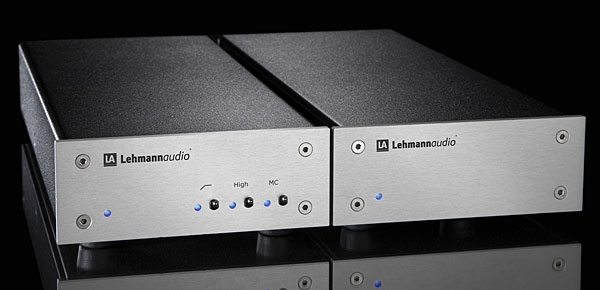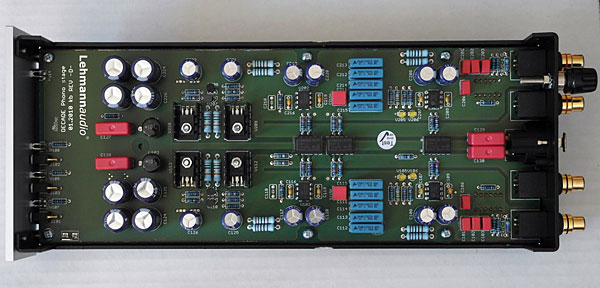| Columns Retired Columns & Blogs |
Listening #137 Page 2
And so it was with the EMT OFD 25 mono pickup head and CineMag Sky 30 transformer. Without the slightest hint of brightness, the combination delivered detail with power, texture with touch. The Sky 30's ultimate forcefulness was a notch or two below that of my more expensive reference step-up device, the Hommage T2 ($4995), yet in every other respect the more affordable transformer punched well above its weight. With the texturally complex recording, by Atrium Musicae de Madrid, of the music of the 13th-century trouvere Thibaut de Navarre (Harmonia Mundi HM 1016)—this time using my EMT TSD15 stereo pickup head—the new trannie provided considerably greater-than-average physical presence and richly textured tone to cromornes, vielles, psalteries, castanets, and all manner of other crazy medieval instruments. And throughout that Stones album, the Sky 30 reminded me that Bill Wyman's bass playing, in its timing and its tone, was often the element that made their sound as exciting and propulsive as it was.
Footnote 1: Then again, in the case of certain MM phono preamps, such as the well-regarded Leben RS-30EQ, the manufacturer recommends the use of a step-up transformer with MC cartridges.
If the CineMag Sky 30 didn't match the very best in terms of ultimate impact, it bowed to no device in its expression of tonal colors. In the second tableau of Act V of Berlioz's Les Troyens (Philips 6709 002, with the late Colin Davis conducting the Royal Opera House Orchestra), the combination of the Sky 30 and EMT TSD15 allowed the bass clarinet to sound beautiful—a rich, colorful, purring sort of thing—in a manner that the Hommage T2 didn't nail quite as well; the Hommage, for its part, spread the extremes of the dramatic range a bit wider, and allowed such things as plucked double-bass notes to stand out in a manner that eluded the Sky 30.
By the way, Bob Sattin lists the Denon DL103, the Miyajima Shilabe, the Accuphase AC-2, and the Koetsu Rosewood Signature among the cartridges with which he tests his devices. That's a pretty wide range of sounds and specs, even if my EMT OFD-series pickups are not the most exemplary of things.
In all, the CineMag Sky 30 is downright amazing for less than a quarter of the price of the reference to which I compared it. That said, $1250 is still a hell of a stretch for most people—especially newcomers to the field of good phonography, whom I would remind that there exist cheaper recommendable transformers. One of my favorites comes from K&K Audio, the US distributor of various products from Lundahl, Sweden's maker of ultra-high-quality audio transformers. The K&K Basic kit, which I wrote about in the September 2007 issue, sells for just $325—the price of a Kiton necktie at Barney's. The K&K Basic can be assembled by anyone with at least one eye and a soldering iron; everyone else can buy the assembled version for just $385. Both are crazy cheap and silly good.
The Decade in Review
As hinted in recent columns, I have two good reasons for listing, alongside every full review I write, all of the reference gear I own and use. First is the usual one, shared by everyone on staff: Only by knowing the context in which a product was tested can the reader fully understand the observations made by the reviewer. My own, second reason is almost as compelling: Since both my approach to the hobby and my playback system differ somewhat from the norms for high-end audio, the supplier with an interest in sending me something to review would do well, for everyone's health and happiness, to note those differences before committing to a review. Put another way: Please don't send something that's doomed to fail in my system—and don't expect me to change my system merely to keep that from happening.
An unexpected consequence of this informal policy: When a supplier who really knows my system persists in offering something that's outside my comfort zone, I can't help wondering about the product that could motivate such confidence. So it was when Louis Dorio, of Ortofon USA, wrote to tell me about the Lehmannaudio phono preamplifiers that his company now distributes in the States. I don't recall his precise words, but it was something along the lines of: No tubes, no transformers—and you'll love the stuff anyway.
With that, he sent me a sample of the Lehmannaudio Decade ($2099), a solid-state phono preamplifier from the same German company that made a splash, over 15 years ago, with a phono stage called the Lehmannaudio Black Cube. The Cube received widespread praise for delivering four-figure sound at a three-figure price; the Decade is aimed at a higher niche. Its high level of performance is said to be a result of company founder Norbert Lehmann's expertise with pro audio in general, and microphone stages in particular.

The Decade is supplied in two separate enclosures of identical size—each takes up the same space as a traditional pack of Fig Newtons—and nearly identical appearance: one for the power supply, the other for the preamp proper. The former is well stuffed with a toroidal transformer, a generously sized heatsink, and a healthy brace of reservoir capacitors. Its front panel is as plain as day, yet the power supply's busy rear panel contains an IEC socket, a power switch, and not one but two DC outlets—the second apparently optimized for use with earlier Lehmannaudio preamps.
The preamp itself contains two class-A, zero-feedback gain stages per channel, sandwiched around a passive RIAA equalization stage. The user selects between moving-magnet (36dB) and moving-coil (56dB) ranges with a front-mounted, miniature toggle switch; another toggle, labeled High, adds another 10dB of gain to whichever range is selected, and thus provides up to 66dB for ultra-low-output cartridges. A third toggle activates Lehmannaudio's Soft Rolloff Filter, reducing sub-60Hz output at a rate of 6dB/octave. Ranges of input capacitance and impedance are selected with two banks of DIP switches on the bottom of the preamp—a useful alternative to having to open the case time and again—while two pairs of internal sockets allow the user to select and install his or her own loading resistors (not included).

The Lehmannaudio Decade was the rare component that, on first listen, surprised me—in a good way. Although experience tells me that all MC cartridges perform their best with a step-up transformer as their first gain stage, whenever I review an MC phono preamp, I do at least try one cartridge straight in, without the transformer, on the assumption that that's what the designer had in mind (footnote 1). In this case, I began with my high-output EMT TSD 15 pickup head, and began with side 2 of Dexter Gordon's One Flight Up (Blue Note/Cisco 84176). That was a hell of a starting place: Art Taylor's drumming sounding almost as impactful as with the CineMag Sky 30 from Bob's Devices! Perhaps more important, the Lehmannaudio preamp reproduced the recording with exceptional musical clarity—a quality that was especially notable in the final 16 measures of the main theme of "Coppin' the Haven," which Gordon and trumpeter Donald Byrd play in unison.
The Decade sounded decidedly transformer-like in a variety of other ways. A good, well-selected transformer has a sufficiently fast way with transients that the consequences of groove damage are made less audible, and so it was when I played a very worn original copy of my favorite version of Elgar's Enigma Variations, by Sir John Barbirolli and the Philharmonia Orchestra (EMI ASD 548). The Decade rendered that record every bit as listenable as my combination of Shindo preamplification and Hommage transformer—and still reproduced even the stoutest kettledrum strokes with satisfying force. Instrumental colors and textures, too, were believable: With "Last Train from Poor Valley," from Norman Blake's The Fields of November (Flying Fish 004), the Lehmannaudio got across the weird beauty of Blake's plaintive, understated voice—and his fine old Martin D-18 guitar.
Yes, the Lehmannaudio preamp could be made even more explicitly forceful with the addition of a good transformer. For example, with my Hommage T2 in place, it was easier to hear how Blake intensifies his strumming as a sort of accent at the end of each singing line: a loose-wristed bang in place of a G run. (While using the EMT straight in, I had the Decade's load impedance set for 100 ohms, and its MC and high-gain modes both switched on. Later, when reintroducing the Hommage T2 step-up transformer, I reverted to the 47k ohm load and the MM setting, without extra gain.) Still, one could do quite nicely with just the Decade. Considered on its own, the Lehmannaudio is easily the most impactful solid-state phono preamplifier I've ever experienced—and one of the most believably dynamic phono preamps of any type. A thoroughly impressive product.
Footnote 1: Then again, in the case of certain MM phono preamps, such as the well-regarded Leben RS-30EQ, the manufacturer recommends the use of a step-up transformer with MC cartridges.
- Log in or register to post comments




































